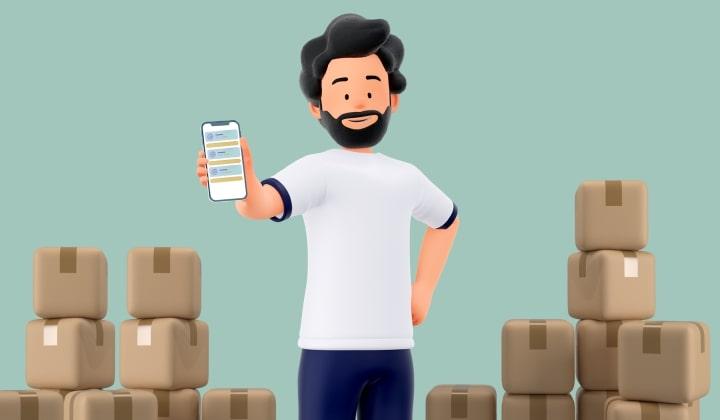Time inevitably makes changes to everything we were used to at some point. Do you remember yourself doing shopping years ago? How did you get your clothes, groceries back in the day? How did you bring new furniture to your apartment? All of these were majorly purchased offline, but the massive growth of electronic commerce popularity has vastly influenced the way we fill our shopping carts, as well as our spending habits.
Before we pass to the subject itself — what types of e-commerce are there — let’s recall what exactly it is.
We all know that e-commerce is any transaction performed on the Internet. It is basically buying goods and services online, as simple as that.
E-commerce is more than just a convenient solution under the conditions of self-isolation. It is also a way to express creativity for founders who were looking for a way to do it. When you start an e-commerce business, you want not only sell goods, but also to advertise business creatively and efficiently. See this article to learn more about business promotion online.
You may have noticed that platforms that sell tools for placing online stores are trying to convince you that a full warehouse is all you need. This is only partly true. To start selling online, one needs to clearly understand which business model they will adhere to. With new tools for e-commerce emerging every once in a while, the rules stay the same.
So, what models of e-business exist? Keep reading to learn types of e-commerce with examples.
What Types of E-Commerce Are There?
Traditionally, there are four types of e-commerce business models. Each of them has its pros and cons, which should be taken into consideration before ecommerce app development starts. Many businesses operate in more than one category of e-commerce at the same time, which is perfectly normal. Additionally, newer models, like dropshipping and print-on-demand, have gained popularity as they allow business owners to reduce inventory costs by outsourcing supply and logistics. These flexible models fit into B2B, B2C, and other e-commerce types, enabling sellers to tailor offerings to varied market needs.
Remember: to improvise, one should know the theory. So let’s dive into e-commerce business models relevant in 2021.
1. B2C — Business to Consumer E-Commerce
This model’s name speaks to itself. The very first paragraph of our article describes exactly this business model. Going to shop for a new pair of trousers, you participate in the business-to-consumer relationship. You, the consumer, buy from a business, the Custom Dickies Work Shirts store, for example.
Many B2C decisions are taken quickly, as they often concern minor purchases with low value. You can hardly disagree that buying a new lawnmower takes much more thinking than purchasing a new shirt. And, most probably, you happen to buy shirts way more often than lawnmowers.
In other words, B2C represents a classical retail trade, and this is what e-commerce generally stands for when a deal takes place online. B2C data enrichment can help businesses better understand their customers and personalize their offerings.
The examples of this business model are at every step. These are either exclusively online stores, like wish, or businesses represented both online and offline, like Sephora, Nike, Tissot, and Swarovski.
However, B2C isn’t just about products like e-commerce sites such as Scent Split that sell fragrances like Bianco Latte perfume, it also involves services. Today’s native advertising and mobile applications are all about promoting services to consumers.
2. B2B — Business to Business E-Commerce
Many B2B businesses rely on enterprise-grade platforms to manage complex pricing structures, bulk ordering, and backend operations efficiently. Again, no surprises here. The process for selling goods from business to business explains this e-commerce business model. These are providers for corporate software, office suppliers, hosting companies, and other services delivered to enterprises.
Speaking about B2B, building up relationships with customers, i.e., other businesses, including office supplies vendors, is critically important. To maintain those relationships at scale, integrating dedicated call center software ensures every client inquiry is tracked and resolved promptly. This is due to the higher purchase value and repeated purchases becoming more frequent.
A clear example of such an e-commerce business model is Alibaba, which gives retailers the opportunity to sell goods on their platform under some conditions. And, as B2B platforms work closely with the business environment and are oriented towards long-term relationships, they require larger investments and support compared to the B2C model.
3. C2B — Consumer to Business E-Commerce
Now things are getting more interesting. The C2B or Consumer to Business model is not something that comes to mind first when we talk about different types of e-commerce. It is the complete opposite of the most traditional B2C model we face every day.
The C2B model allows consumers to provide businesses with goods and services. In other words, it is equal to a sole proprietor serving a bigger company.
This method empowers the individuals with the right to assign prices to services and interact with businesses on their terms. Thus, the consumer requests service for a price they can afford and waits until a business delivers this service. Alternatively, the consumer might be a service provider for a business.
Traditionally, businesses and consumers interact via an intermediary. For example, when a freelance photographer sells their images to a stock website, the latter acts as an intermediary. Or when a blogger places some business’ ad on their social media account, platforms like Instagram or YouTube are this connecting link. C2B is very much about marketing and promotion. The Internet allows individuals to find an interested party very easily, which is essential for building a profitable online business.
4. C2C — Consumer to Consumer (Customer to Consumer) E-Commerce
First off, please note that the “Customer to Consumer” explanation is generally equal to the “Consumer to Consumer” one, and this variability should not provoke confusion. We decided to mention both to clarify this issue.
C2C e-commerce is about facilitating transactions between two end-users. Its main task is to connect two private parties with one another. Comprehensive website content plays a crucial role in explaining the platform's functionality and attracting users. Such an interaction might take place on platforms like eBay, either auction websites like Craigslist, or auction apps, and others. Intermediary websites that allow placing an advertisement, from their end, may charge fees for providing a platform and creating engaging website content that enhances user experience.
The selling party assigns a price to the item for sale, and the purchasing party decides on whether this offer is worth their attention or not.
The best thing about this business model is that through business process analysis an individual might identify and be willing to sell something impossible to find elsewhere. These may be items out of stock for years, of which their owner decided to get rid. It is this feature that makes C2C e-commerce so unique.
The same goes for crowdfunding activities (voluntary financing of some beginner idea), bartering (exchanging goods or services with no money involved, i.e., trading a Samsung smartphone for an iPhone), or repairment services (help with fixing something) found online.
5. D2C — Direct to Consumer E-Commerce
In addition to the four traditional forms of e-commerce, there is a relatively new one — the D2C model. Its main feature is immediate services delivery to the customer. The manufacturer provides its end-consumers with goods with no other parties involved. Speaking of selling products, the D2C model usually covers smaller-scale businesses. It is easy to explain: larger manufacturers will not manage to process all orders at the same speed and with the same accuracy as smaller ones.
A marketplace can not represent a D2C business model. D2C e-commerce is the brand made flesh, so it is all about individuality — the marketplaces’ complete opposite.
We can also mean D2C, speaking of subscription services like Netflix. For a fixed fee, consumers access content streamed through the platform. However, we mentioned that businesses can combine different types of e-commerce for a reason. The same Netflix is a hybrid e-commerce business. It targets mass-market consumers, on one hand, making it a B2C platform, and gives a platform and budget to filmmakers, on the other hand, which makes it a B2B business. It is the same with Spotify, another subscription service. Versatility makes these and many platforms alike so sustainable and successful.
Conclusion
What is the company type if you would like to start your own business in retail? The main advice stays the same no matter which business model one chooses. It is to learn the consumer demand and market trends. Stand by your business plan and watch your competitors.
We hope that knowing these e-commerce models will help you stay confident and successful. For both founders and just curious ones, it is useful to know how things work in the end.



.jpg&w=750&q=75)